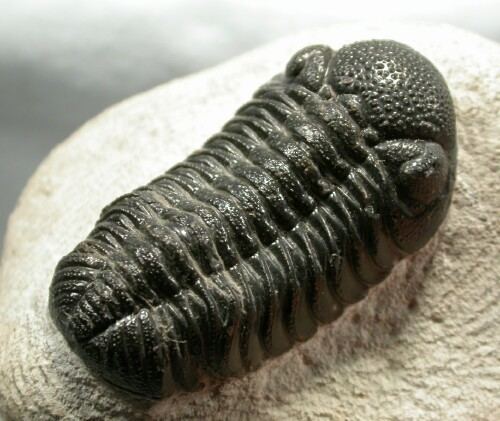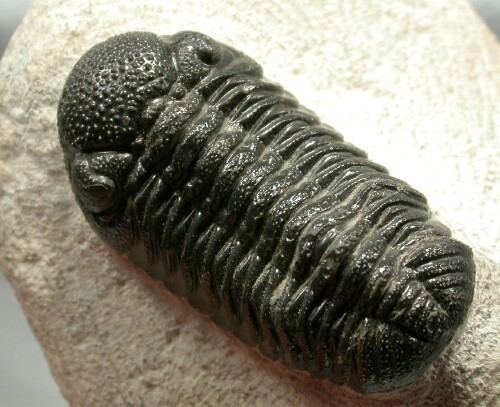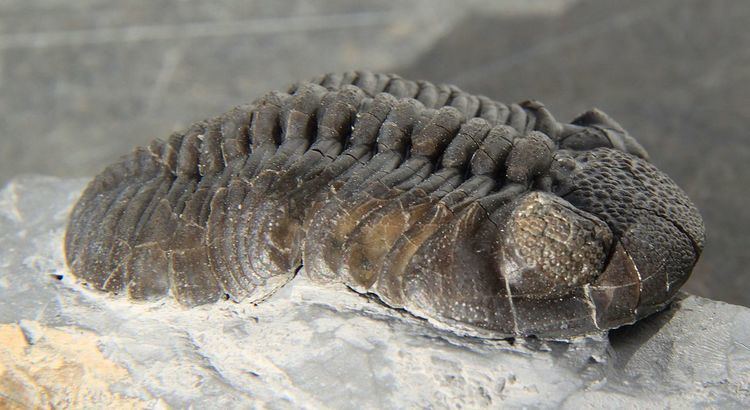Scientific name Phacops Rank Genus | ||
 | ||
Similar Trilobite, Phacopida, Calymene, Phacopidae, Eldredgeops | ||
Phacops trilobite
Phacops is a genus of trilobite in the order Phacopida, family Phacopidae, that lived in Europe, northwestern Africa, North America and China from the early until the very end of the Devonian. It was a rounded animal, with a globose head and large eyes, and probably fed on detritus. Phacops is often found rolled up, a biological defense mechanism that is widespread among smaller trilobites but further perfected in this genus.
Contents
- Phacops trilobite
- Www fossilplanet com drotops armatus fossil trilobite spiny phacops middle devonian
- Description
- Camouflage
- Taxonomy
- Species
- Species previously assigned to Phacops
- References

Www fossilplanet com drotops armatus fossil trilobite spiny phacops middle devonian
Description

Like in all sighted Phacopina, the eyes of Phacops are compounded of very large, separately set lenses without a common cornea (so called schizochroal eyes), and like almost all other Phacopina, the articulate mid-length part of the body (or thorax) in Phacops has 11 segments.

The central raised area (or glabella) of the headshield (or cephalon) is moderately to strongly inflated near to its front, more or less flattened on the top, falling vertically to or slightly overhanging the border furrow. Up to three lateral furrows may be discernable on the glabella behind the utterly dominating frontal lobe. From the back there is a very distinct occipital ring, and in front of that a distinct preoccipital ring which is weakly divided into a strongly convex central lobe and weakly convex lateral lobes. The large to medium size eyes have a crescent shaped outline, and are elevated high above the cheeks. The steep visual surface is kidney shaped. The back corners of the cephalon (or genal angles) are acutely to bluntly rounded, but a genal spine is lacking in adults. In the ventral surface of the seam (or doublure) is in the frontal half of the cephalon a continuous furrow, delineated by ridges, and with notches laterally. This so-called vindicular furrow serves to lock the rim of the tailshield to the headshield when the trilobite is enrolled.

The axial rings of the thorax do not have convex lateral axial nodes on its outer surface. The tailshield (or pygidium) is well segmented. The pygidial axis has 9 to 11 rings, and the pleural areas to the sides have 5 to 8 pairs of recognizable ribs. Furrows between the ribs are deep, those that divide each rib in frontal and rear bands are very shallow, and the frontal bands are widest. The surface of the exoskeleton is covered in tubercles.
Camouflage

There are specimens known of Phacops rana with many irregular black spots. Because similar spots in a specimen of Greenops boothi from the same site are arranged in rows, it may be assumed that they are original and not caused by the fossilisation process. The spots are irregular and have spurs branching outwardly, similar to the melanophores in many extant animals. In one specimen, the black spots are much larger than in another one. It is quite conceivable that changing the size of the melanophores enabled Phacops rana to camouflage itself in different environments.
Taxonomy
The concept of many fossil taxa has been tightened over time, including Phacops. As a result, Boeckops, Chotecops, Paciphacops, Prokops and Viaphacops have been erected as subgenera of Phacops, and are now widely regarded as genera in their own right. Most recent, it was considered that some North-American/African species on the one hand and European species on the other hand differ sufficiently from each other to be assigned to separate genera. As the type species is the European P. latifrons, the North-American species are now called Eldredgeops. However, the old combinations like Phacops rana are still widely used among fossil collectors. Eldredgeops has a raised ridge along the ventral margin of the cephalon, the glabella is more inflated, the lateral parts of the preoccipital ring are rectangular (and not round), the palpebral area and palpebral lobe and larger than in P. latifrons, and there is no fold right behind the posterior vertical row of lenses nor an isolated raised area just below the lenses. Not all of these characters may differentiate between Eldredgeops and other Phacops species however.
During the Eifelian in the Ardennes, several Phacops species developed from each other, the oldest being P. imitator, followed by P. fragosus, then P. latifrons and finally P. sartenaeri. These species show a decrease in the number of lenses, which is a more widespread and recurring trend in many Phacopinae.
Species
Phacops currently contains the following species:
Species previously assigned to Phacops
A number of species previously assigned to the genus Phacops have since been transferred to other genera:
